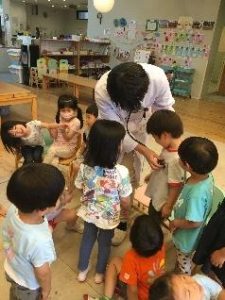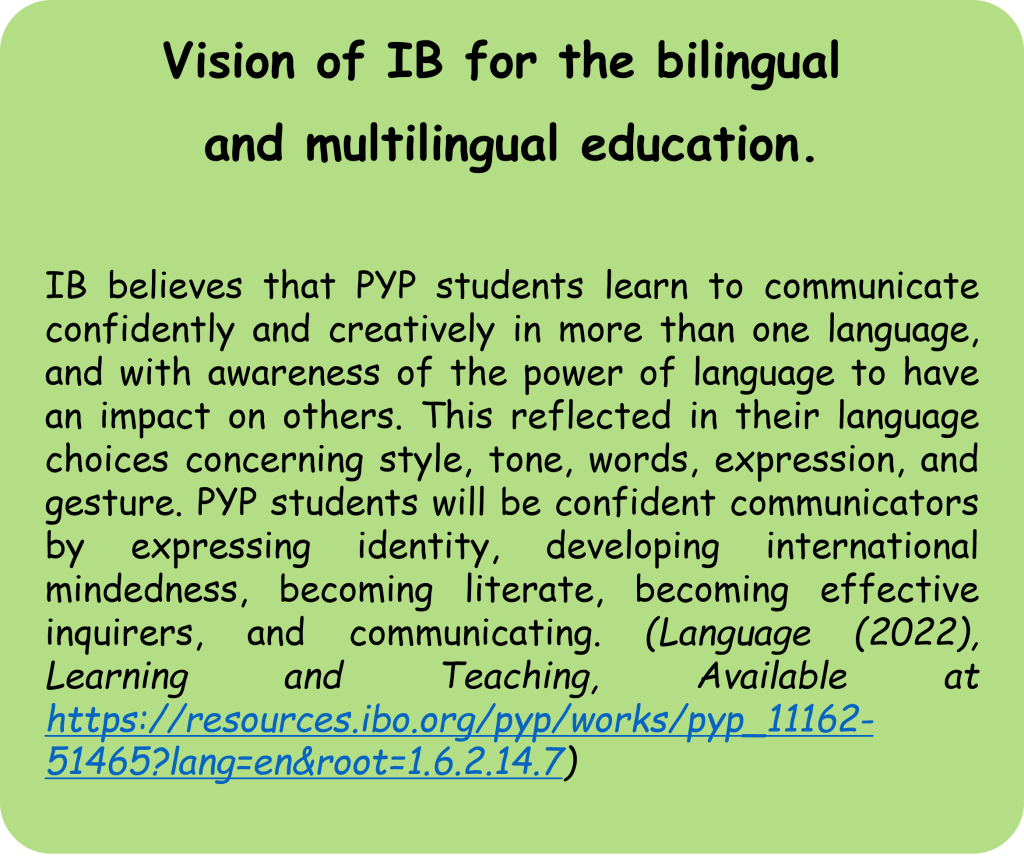At Aoba-Japan Bilingual Preschool, we offer children the opportunity to learn English as required in the IB programme standards and practices. We believe that exposure to more than one language and bilingualism offer multiple perspectives, not only linguistically, but in all areas of life and learning.

(Nakano K4 – July 2023)
Benefits
Cognitive Development:
1. Enhanced Cognitive Flexibility :Learning two languages requires the brain to constantly switch between languages, which can enhance cognitive flexibility and adaptability. This skill can extend to other areas of learning, making it easier for children to grasp complex concepts and solve problems.
2.Improved Thinking Skills:Bilingual children often exhibit better problem-solving abilities, as their exposure to different linguistic structures encourages them to think creatively and approach challenges from various angles.
3.Enhanced Logical Reasoning:The cognitive demands of managing two languages can enhance logical thinking and reasoning skills. This can be beneficial not only in language-related tasks but also in subjects like mathematics and science.
4.Effective Decision-Making: Bilingual children develop strong executive function skills, including the ability to focus, remember information, and make decisions. These skills are crucial for academic success and personal growth.
5.Language Awareness:Learning multiple languages fosters an increased awareness of language structures, which can lead to improved communication skills and a deeper understanding of how languages work.

Image credit:Grant A, Dennis NA and Li P via Wikimedia

Social-Emotional Development
1. Cultural and Community Connections: Bilingualism allows children to maintain strong ties with their family's culture and heritage, enabling them to communicate with relatives and engage in cultural practices more effectively.
2.Diverse Relationships: Being able to communicate in two languages empowers children to connect with a wider range of people, fostering inclusivity and understanding among diverse groups.
3.Adaptability and Open-Mindedness: Bilingual children often develop a greater capacity for empathy and open-mindedness, as they understand that different languages reflect different perspectives and experiences.
4.Increased Social Skills: The ability to communicate in multiple languages helps children navigate different social situations and form relationships with peers from various linguistic backgrounds.
5.Preparation for Multicultural World: In our increasingly globalized world, the ability to communicate in more than one language is an asset. Bilingual children are better equipped to succeed in diverse professional and social environments.

Bilingual Education Environment at Aoba-Japan Bilingual Preschools.
The bilingual education environment at Aoba-Japan Bilingual Preschools appears to be well-structured and designed to foster comprehensive development in children while promoting language acquisition and cross-cultural understanding. Here's a more focused description of the features you've highlighted:
1. Collaborative Exploration: Aoba-Japan Bilingual Preschools prioritize collaboration between students and teachers to explore a diverse range of educational concepts and transdisciplinary themes. This collaborative approach encourages critical thinking, problem-solving, and the development of well-rounded skills.

(Nakano campus K4 – April 2023)

2.Language Integration through Play: Language outcomes are seamlessly integrated into play-based learning activities. This approach engages children in meaningful interactions while promoting language acquisition in both Japanese and English. Play-based learning also enhances creativity and imaginative thinking.


3.Multicultural Exposure: The preschool places an emphasis on multicultural awareness. By introducing children to various cultures through events, discussions, and literature, they develop a broader understanding of the world and learn to appreciate diversity. The multicultural exposure offered by the preschool helps children develop cultural sensitivity, empathy, and an appreciation for different perspectives. These qualities are essential for global citizenship and harmonious coexistence in a diverse world.

4.Inquiry-Based Learning: The transdisciplinary themes and central ideas suggest an inquiry-based approach to education. This encourages children to ask questions, investigate, and explore topics deeply, fostering a love for learning and a genuine curiosity about the world.

Show and Tell (Presentation): Encouraging children to participate in English and Japanese Show and Tell presentations is an excellent way to nurture communication skills, self-confidence, and public speaking abilities. By linking the topics to transdisciplinary themes and central ideas, children develop a deeper understanding of the concepts they're exploring.

5.Parent Involvement: Involving parents in the learning journey enhances the overall educational experience. Regular communication, workshops, and family events can help parents support their children's language development and engagement with the curriculum.

(Mitaka campus K4 - June 2023)

6.Professional Development: Teachers at Aoba Japan Bilingual Preschools likely receive ongoing training and professional development to effectively deliver a bilingual and culturally inclusive curriculum. This ensures that the quality of education remains high.
How To Support Your Child’s Bilingual Learning at Home
- Follow up the daily journals about activities of the day from your child’s homeroom teachers → Reflect, review, and discuss at home with your child.
- Use basic daily keywords/ conversations in English which you are confident with, such as “Are you hungry?”, “Which ice cream do you like? Strawberry or chocolate?”, “Which game was fun at school today?”
- Sing and dance to your child’s favourite songs.
- Read storybooks with multi-cultures around the world → Build up your child’s international mindedness.
- Play card games with basic sentence structures.
- I spy in my eyes a/ an…. (Vocabulary of the card which you want your child pays attention to)
- I found it! I see a/ an…. (Touch the card and express the feeling)
- Explore and get familiar with phonics/ sounds.



Nguyen Tran:I have been involved in international education in Japan since 2012 (including the IB curriculum, Montessori, Grapeseed, and Jolly Phonics), with the Bachelor of Early Childhood and Primary Education as well as the Teacher License of Melbourne-Victoria in Australia.
I started to be a member of the Aoba International Education Organization in 2016 and moved from being a homeroom teacher to being a PYP Coordinator in 2022 is also a significant step for me.
Teaching in both Melbourne, Australia, and Tokyo, Japan, and experiencing different school contexts must have given me valuable insights and skills. I am very pleased to give parents and colleagues the wealth of experience they have likely encountered with various teaching methodologies, classroom management techniques, and strategies for engaging young learners.

